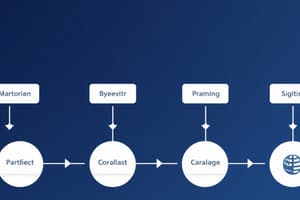Podcast
Questions and Answers
What impact does an aging population have on business operations?
What impact does an aging population have on business operations?
- It leads to an increase in market competition.
- It reduces the average age of the workforce.
- It affects recruitment and spending patterns. (correct)
- It decreases consumer spending overall.
Which phase of the business cycle is characterized by rising employment and spending?
Which phase of the business cycle is characterized by rising employment and spending?
- Boom (correct)
- Recovery
- Recession
- Slump
What is one of the primary benefits of using a STEEPLE analysis?
What is one of the primary benefits of using a STEEPLE analysis?
- It focuses solely on financial forecasts.
- It encourages reliance on gut feelings.
- It limits the analysis to internal factors only.
- It promotes pre-emptive thinking. (correct)
How can technological advancements create barriers to entry for businesses?
How can technological advancements create barriers to entry for businesses?
How does a circular business model (CBM) differ from traditional business models?
How does a circular business model (CBM) differ from traditional business models?
What is a potential consequence for businesses that do not consider environmental impacts?
What is a potential consequence for businesses that do not consider environmental impacts?
Which factor is NOT typically examined in a STEEPLE analysis?
Which factor is NOT typically examined in a STEEPLE analysis?
What term describes a period of declining economic activity, leading to reduced employment and confidence?
What term describes a period of declining economic activity, leading to reduced employment and confidence?
Which of the following statements accurately reflects the implications of net migration rates for businesses?
Which of the following statements accurately reflects the implications of net migration rates for businesses?
What is a primary outcome managers can achieve by using a STEEPLE analysis?
What is a primary outcome managers can achieve by using a STEEPLE analysis?
What effect can a positive corporate image have on a business?
What effect can a positive corporate image have on a business?
Which of the following is a characteristic of traditional business models?
Which of the following is a characteristic of traditional business models?
Which factor can influence a business's marketing strategies based on economic conditions?
Which factor can influence a business's marketing strategies based on economic conditions?
Which aspect does ethical marketing practices in a STEEPLE analysis relate to?
Which aspect does ethical marketing practices in a STEEPLE analysis relate to?
Which of the following best describes a key utility of a STEEPLE analysis?
Which of the following best describes a key utility of a STEEPLE analysis?
What does a business gain from performing a STEEPLE analysis?
What does a business gain from performing a STEEPLE analysis?
How does the amount of available finance impact a firm's objectives?
How does the amount of available finance impact a firm's objectives?
What is one potential effect of government constraints on business objectives?
What is one potential effect of government constraints on business objectives?
What objective typically characterizes newly established firms?
What objective typically characterizes newly established firms?
How does the state of the economy generally influence business objectives?
How does the state of the economy generally influence business objectives?
What is the purpose of conducting a STEEPLE analysis?
What is the purpose of conducting a STEEPLE analysis?
Which of the following rightly captures a consequence of a firm's high risk profile?
Which of the following rightly captures a consequence of a firm's high risk profile?
What kind of changes can STEEPLE factors bring to a business?
What kind of changes can STEEPLE factors bring to a business?
In financial forecasting, which factor is typically not considered important?
In financial forecasting, which factor is typically not considered important?
Flashcards
STEEPLE Analysis
STEEPLE Analysis
A framework to analyze external factors affecting businesses, used to identify opportunities and threats.
External Factors
External Factors
Elements outside a business that can influence its performance.
Circular Business Models (CBMs)
Circular Business Models (CBMs)
Business models that focus on environmental sustainability, aiming to recycle waste as resources.
Traditional Business Models
Traditional Business Models
Signup and view all the flashcards
Pre-emptive Thinking
Pre-emptive Thinking
Signup and view all the flashcards
Opportunities (Business)
Opportunities (Business)
Signup and view all the flashcards
Threats (Business)
Threats (Business)
Signup and view all the flashcards
Ethical Marketing Practices
Ethical Marketing Practices
Signup and view all the flashcards
Aging population
Aging population
Signup and view all the flashcards
Net migration rate
Net migration rate
Signup and view all the flashcards
Increased retirement age
Increased retirement age
Signup and view all the flashcards
Business cycle
Business cycle
Signup and view all the flashcards
Boom
Boom
Signup and view all the flashcards
Recession
Recession
Signup and view all the flashcards
Slump/trough
Slump/trough
Signup and view all the flashcards
Environmental factors in business
Environmental factors in business
Signup and view all the flashcards
Finance impact on objectives
Finance impact on objectives
Signup and view all the flashcards
Risk tolerance & objectives
Risk tolerance & objectives
Signup and view all the flashcards
Crisis & Objective Shift
Crisis & Objective Shift
Signup and view all the flashcards
Economic impact on objectives
Economic impact on objectives
Signup and view all the flashcards
Government constraint on objectives
Government constraint on objectives
Signup and view all the flashcards
Business age & objective
Business age & objective
Signup and view all the flashcards
STEEPLE Analysis Definition
STEEPLE Analysis Definition
Signup and view all the flashcards
Role of Monitoring in Business
Role of Monitoring in Business
Signup and view all the flashcards
Study Notes
Nature of Business
- Businesses exist to meet customer needs and wants, often by selling goods and services for profit.
- They combine human, physical, and financial resources to create products and services.
How Businesses Add Value
- Transforming raw materials into finished products.
- Designing innovative products.
- Providing quality products and efficient services.
- Effective marketing strategies.
Quaternary Sector
- Part of the tertiary sector.
- Involves the creation and sharing of knowledge and information.
- Includes activities like education, consultancy, and software development.
Successful Entrepreneurs
- Risk-takers, willing to take calculated business risks.
- Innovative, with creative and original thinking.
- Strategic thinkers, able to develop and implement effective plans.
- Enthusiastic and driven.
- Resilient, able to handle setbacks and feedback.
Reasons for Starting a Business
- Financial reward.
- Autonomy (being your own boss).
- Passion for the product or service.
- Family ties (entrepreneurship in the family).
- Unfilled market opportunities.
- Making a difference (social enterprise).
Business Plan Purpose
- Increased chances of success with a well-planned strategy.
- Securing finance by demonstrating business viability.
Added Value
- The amount added to production costs by the business process (design, marketing, unique selling points).
- Calculation involves subtracting production costs from the sale price.
Primary Sector
- Extracts and grows raw materials.
- Examples include farming, fishing, and mining.
Secondary Sector
- Manufacturing and construction of raw materials into finished goods.
- Examples include manufacturing and construction.
Tertiary Sector
- Involves providing services.
- Examples include retail, transportation, and healthcare.
Entrepreneur
- Combines the factors of production (human, natural, capital, and entrepreneurship).
- Takes on risks to start a business.
Challenges for New Businesses
- Lack of knowledge, skills, and experiences.
- Lack of market research.
- Lack of finance.
- Long hours.
- Poor marketing strategies.
- Limited human resources.
Business Plan
- Detailed description of a new or existing business.
- Includes company objectives, marketing, and financial plans.
Business Plan Contents
- Executive summary (overview of the business and its objectives).
- Introduction (overview of the business, legal structure).
- Market analysis.
- Product analysis.
- Financial analysis (projections, budgets).
- Marketing strategy.
Private Sector Definition
- Businesses owned by private individuals or organizations.
- Usually, but not always aiming to earn profit.
- Includes charities, NGOs, and not-for-profit social enterprises.
- Operates independently from government but needs to comply to nation's rules and regulations.
Public Sector Definition
- Businesses controlled by a regional or national government.
- Aim to provide essential services for the general public.
- May or may not directly charge for services.
Incorporation
- A legal distinction between business owners and the business itself.
- Limited liability: Owners are only liable up to the amount of their investment.
- Unlimited liability: Owners are liable for all debts of the business.
Sole Trader
- Business owned and run by one person.
- Owner keeps all profits, makes all decisions.
- Unlimited liability (owner is responsible for all debts).
- Limited funds due to sole ownership.
- High workload.
Partnership
- Business owned by two or more people.
- Profits shared among partners.
- Unlimited liability (but partners may have different responsibilities).
- Potential disagreements among partners during decisions.
- More access to capital than sole traders.
- More expertise available.
Private Limited Company
- For-profit business owned by a limited number of shareholders.
- Shares cannot be sold publicly.
- Less risk to shareholders than other forms.
- Limited liability (shareholders are not liable for company debts).
- Restrictions to selling shares.
Public Limited Company
Business owned by shareholders.
- Shares are sold publicly on the stock exchange.
- Easy to raise large amounts of capital.
- Greater ability to expand compared to other types.
- Limited liability.
- Financial obligations to the shareholders in the form of yearly reports.
- Risk of loss of control if another entity buys more than 50% of the shares.
Social Enterprises
- Aim to solve social or environmental problems while creating revenue and profits.
- May or may not be financially dependent on NGOs.
Cooperatives
- Owned and run by members (customers or employees).
- Profit-sharing amongst members.
- Equal voting rights for members.
Advantages of Being a Social Enterprise
- Positive impact on society/environment.
- Potential for revenue and profit.
- Possibility to improve financial stability through social programs.
Business Objectives
- Clear targets set to achieve overall company goals.
- Measurable, and specific examples include sales growth or profitability targets.
Vision Statements
- Organisational long-term aspirations
- Should inspire.
Mission Statements
- Explains the core purpose and objectives for the short-term
- Provides insight on how they want to achieve the long-term goals.
Operational Objectives
- Short-term goals (less than a year).
- Specific and measurable.
SMART Objectives
- Specific: Clearly defined.
- Measurable: Able to be measured.
- Achievable: Realistic for the business to reach.
- Relevant: Directly related to the overall company objectives.
- Time-bound: Specific time limit for completion.
Ethical Objectives
- Business goals based on social values and beliefs.
Ethical Marketing Practices
- Practices that prioritize ethical standards for the business.
- Protecting intellectual property.
- Sustainable operations.
Circular Business Models
- Focus on long-term environmental concerns and sustainability for business activities.
- Waste is converted into valuable resources.
- Business models reduce consumption and increase resource efficiency.
STEEPLE Analysis
- A business planning framework that can help identify external factors (social, technological, economic, environmental, political, legal, ethical).
Studying That Suits You
Use AI to generate personalized quizzes and flashcards to suit your learning preferences.




